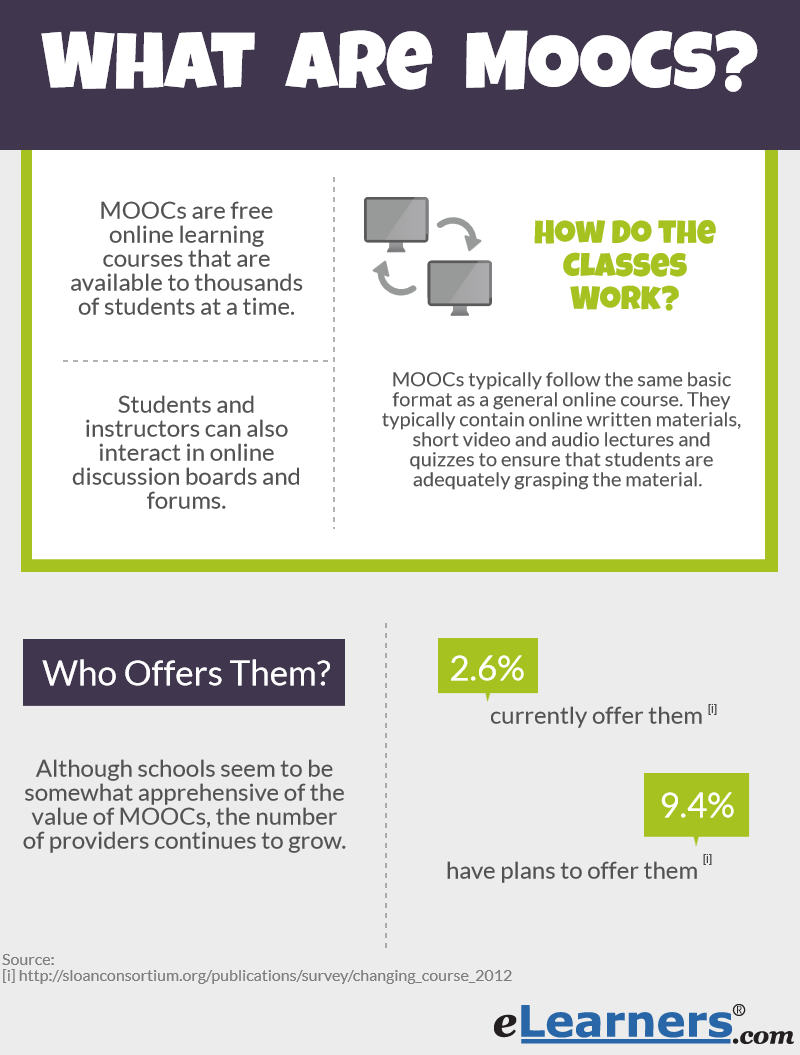MOOCs, or massive open online courses, are free online learning courses that are available to thousands of students at a time. For example, a recent MOOC offering, “Think Again: How to Reason and Argue”, co-taught by two professors from Duke and University of North Carolina saw an unprecedented 180,000 students register for the online course. [i]
Understandably, MOOCs have been getting a lot of media attention in the last six months, due in large part to their ability to make education free and accessible to anyone with an internet connection – and the controversy about their long-term feasibility.
How Do the Classes Work?
MOOCs typically follow the same basic format as general courses offered by online colleges. They typically contain online written materials, short video and audio lectures and quizzes to ensure that students are adequately grasping the material. Students and instructors can also interact in online discussion boards and forums.
In some cases, schools may offer MOOCs through iTunes U, which allows professors to build online courses that students can access on their iPads through a free app.
How Do Educators Feel About MOOCs?
According to the Sloan Report’s 2012 Survey of Online Learning, only 2.6 percent of institutions indicated they currently offer MOOCs and just 9.4% said they have plans to offer them. [ii] This is somewhat surprising, so let’s take a look at some more interesting findings from the report:
- Public universities currently show greater instances of offering MOOCs (4.7%), while private, for profit schools are most likely to be in planning stages (15%).
- Larger schools (15,000+ students) have a higher rate of offering MOOCs (8.9%), while over twenty percent are in the process of planning to.
- Chief academic officers seem to agree that MOOCs offer a way for institutions to learn about online instruction (less than 20% of institutions disagree).
- 27.8 percent of academic leaders agree that MOOCs are a sustainable course method, while 27% disagree.
- Although public institutions currently offer the greatest number of MOOCs, chief academic leaders at these schools show the highest percentage of believing MOOCs are not a sustainable course method. [ii]
Who are Some of the Major Providers?
Although schools seem to be somewhat apprehensive of the value of MOOCs, the number of providers continues to grow. Below is a list of some of the major players in the MOOC landscape, with brief descriptions of the types of courses available.
- Coursera: Offers 222 courses in subjects including computer science, math, business, humanities, social science, medicine, engineering and education.
- Udacity: Focuses on computer science, mathematics, physics and business courses.
- Stanford Engineering Everywhere (SEE): Offers 10 courses from Stanford’s School of Engineering.
- UC Berkeley: Offers a variety of courses including everything from General Biology to Human Emotion.
- MITx: Offers a long list of courses in subject areas including business, energy, fine arts, health and medicine, mathematics and science.
- Duke University: Uses ITunes U to deliver courses in a variety of topics.
- UCLA: Course offering includes their writing program, which provides 220 online writing courses annually.
- Harvard: Offered through edX (a Harvard and MIT initiative), courses include everything from Shakespeare to Abstract Algebra.
[i] huffingtonpost.com/2013/01/22/duke-university-mooc_n_2525547.html | [ii] sloanconsortium.org/publications/survey/changing_course_2012

